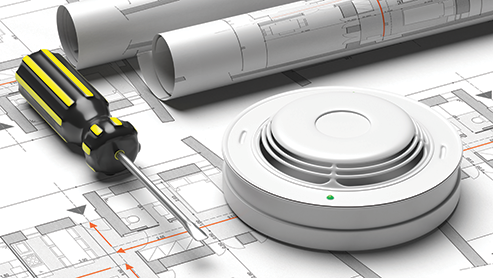Smoke & Fire Alarms: Know the Basics

Today’s home and business owners understand the importance of smoke alarms and the substantial impact these devices have in reducing property damage, injuries, and fatalities due to fire.
However, individuals are probably less familiar with the different types of alarms, detectors, and fire protective systems on the market.
To help our policyholders make an informed choice, we offer some basic definitions here. For further details and advice, we recommend consulting with an insurance agent, local fire department, and/or licensed professional – particularly regarding rules and regulations by city, state, and borough.
SMOKE ALARMS
- Stand-alone smoke alarms are the popular choice for residential dwellings and small facilities. While most are battery operated, some can be hard wired to a property’s electric power supply and interconnected (recommended). The units work through a sensor that monitors for smoke. When detected, an alarm will sound.
- Smoke alarms can be ionized or photoelectric. Ionized units are more responsive to fast-burning, flaming fires while photoelectric units react to smaller, smoldering fires. Dual-sensor models are available and considered the best choice.
- Smoke alarms with strobe lights are helpful for the hearing impaired.
- Sealed alarms are available and come with a 10-year battery.
SMOKE DETECTORS
- Smoke detectors are different than smoke alarms and are strictly sensing devices. These units serve to detect combustion (smoke) and are connected to a building’s fire alarm system which then sounds an alarm.
NON-SMOKE DETECTORS
- Heat detectors do not detect smoke at all but provide an alert to an unexpected rise in air temperature caused by flames. While ideal for kitchen areas (to avoid false smoke alarms), these units are not recommended to replace smoke detectors altogether or in non-kitchen areas.
- CO detectors use sensors to detect the presence of carbon monoxide (CO). Some models have a display to show the level of CO. Combination models contain a smoke alarm component and are popular options.
FIRE ALARM SYSTEMS
- A fire alarm system has a number of devices all joined together. The components are interconnected, so a fire detected in one area will set off the main alarm.
- Conventional systems interconnect components to one main control panel. These systems are relatively inexpensive and work well for smaller facilities. The downside is that a conventional system does not identify exactly where the fire alert has been detected.
- Addressable systems are well-suited for larger facilities because the components have individual identities. This allows the system to pinpoint the exact location of a fire.
- A connection to an off-site central station monitoring company is encouraged and sometimes required for insurance purposes.
- All systems should be connected to reliable primary (electric utility, generator) and secondary (batteries, standby generator) power sources.
PLACEMENT, TESTING, AND MAINTENANCE
- Install smoke alarms on all floors (including basements and attics), in every sleeping room, and outside each separate sleeping area. Note that a closed door may slow the spread of smoke, heat, and fire.
- Place devices on the ceiling or high on the wall 18 inches from corners and 3 feet from ceiling fans.
- Test all types of units monthly.
- Replace lead or alkaline batteries two times per year.
- Clear devices of dust and other dirt at least twice per year. (Heat detectors are often used in dusty or dirty environments and need to be cleared more often than household smoke alarms. Follow the manufacturer’s specification for cleaning.)
- Replace heat and smoke detectors every 10 years to achieve optimal performance.
- For more tips and information, review the National Fire Protection Association’s Standard for Fire Alarms and Signaling Systems (NFPA 72) at www.nfpa.org.
RESOURCES
NFPA
https://www.nfpa.org/Public-Education/Staying-safe/Safety-equipment/Smoke-alarms
U.S. Fire Administration
https://www.usfa.fema.gov/prevention/outreach/smoke_alarms.html
American Red Cross
https://www.redcross.org/content/dam/redcross/atg/PDF_s/Preparedness___Disaster_Recovery/General_Preparedness___Recovery/Home/FireSmokeAlarmFactSheet.pdf
Disclaimer: The GUARD Wire is designed to provide general information about various topics of interest and should NOT replace the guidance, advice, or recommendations from licensed insurance or legal professionals, other industry experts, or state and federal authorities.


